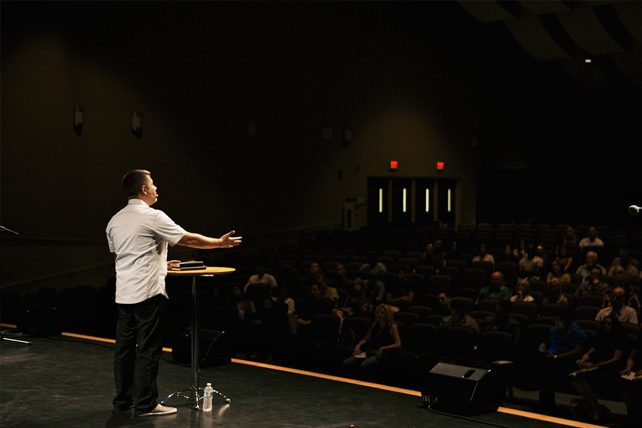At evangelical Protestant churches, variations of the phrase “eternal hell” are most distinctive yet appear in just 10 percent of sermons. Meanwhile, worshipers at those churches “had a 99 percent chance of hearing the word ‘love,’” Pew notes. Other commonly heard terms include “salvation,” “sin,” and “heaven.”
At historically black Protestant churches, distinctive phrases represent celebration; for example, “powerful hand,” “hallelujah,” and “praise.”
Sermons Are Scripture-Infused—Especially With the NT
Of the sermons studied, 95 percent reference at least one Bible book by name, and 56 percent cite both an Old and New Testament book. While a New Testament book is mentioned in 90 percent of the sermons, the Old Testament gets name-checked in just 61 percent. Smaller churches are more likely to cite a specific Old Testament book.
In evangelical churches, sermons are most likely to reference a particular Bible book (97 percent) and to name both an Old and New Testament book in the same sermon (62 percent).
The timing of Easter—and use of the common lectionary—likely affects the results, Pew notes. Old Testament references dropped near Easter week but later bounced back.
‘A sermon is the fruit of your labor’
Dennis Quinn, the computational social scientist who spearheaded Pew’s “big-data approach” to studying sermons, admits being “in awe of…the sheer volume of information” they analyzed. His team tried to “steward” the information respectfully, he says, and made no attempts to access password-protected pages.
Online sermons were found on about 6,000 of the 38,000 church websites Pew examined. “If you think about it from a pastor’s perspective,” says Quinn, “a sermon is the fruit of your labor, so it’s not necessarily outlandish that you’d want it to be heard by the broader world—or, for that matter, available to congregants who can’t make it to church.”
When asked about possible follow-up projects, Quinn says he’d like to learn more about “the real humans on both sides of the altar,” exploring pastor’s opinions, sermon contents, and how those messages affect congregants’ opinions.
Sermons are just one form of “meaningful communications” that occur between clergy and churchgoers, Pew acknowledges. But this study harnesses technology to provide a systematic, objective look at a significant chunk of the material actually being preached on Sundays.
In its coverage of the “Digital Pulpit” study, the Associated Press quotes two pastor-scholars about the sermon-length debate. The Rev. Hershael York, a professor at the Southern Baptist Theological Seminary, once wrote that his decades in ministry had yielded this “definitive answer”: “You can preach as long as you hold [people’s] attention.”
The Rev. John Piper, who once told churchleaders.com he starts preparing his sermons on Fridays, says a message usually has to be 40 minutes or longer to cover themes adequately. “There are many hundreds, maybe thousands, of growing [U.S.] churches where pastors preach rich, Christ-exalting, God-centered, Bible-saturated, textually rooted, intellectually challenging, emotionally moving, life-altering sermons for 50 or more minutes, and very few people get frustrated that they are too long,” Piper said during a Q&A forum last year.

